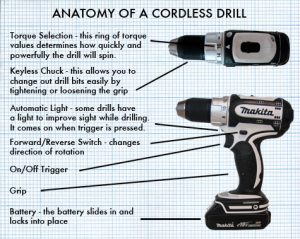Cordless Drill Guide
A cordless drill is useful for many tasks such as:
Primary uses for a cordless drill
![]() Tedious screwing jobs, such as in construction or assembly
Tedious screwing jobs, such as in construction or assembly- Drilling holes into a wall or other surface
What else I have used my cordless drill for
- Hammering in a nail
- Pretending it is a ray gun to my wife when she walks into the room
- Twisting wires during an electrical install
If you are doing a major home renovation, or just doing some basic home improvement tasks, a cordless drill is almost always the go to tool for such jobs.
5 factors that can effect which cordless drill you buy
- SIZE – The actual size of the latest cordless drills is a good deal small compared to the drills of only 12 months back. The innovative sub-compact lithium drill/drivers weigh in at 2 lbs. The comparable NiCad powered cordless drill of only 2 yrs. ago weighs in at 5 .2 lbs. The latest drills are much easier to hold and enable you to access small areas. Almost all the modern drills include lights to assist you see on the inside of closets and operate in regular home lighting conditions. The truth is most of the modern drills will easily fit into your kitchen drawer.
- TORQUE – When I discuss a cordless drill’s power, I am actually speaking about the amount of rotational force, or torque, it generates. I am not referring to the battery voltage. This rating, in inch-pounds will allow you to compare one drill to the other and evaluate if the drill is adequate enough for the jobs you would like it to perform. 180 inch/lbs. is ample power for the majority of drilling, screwing and repair tasks around the house, 320 inch/lbs. is as much as necessary for the majority of house construction and remodeling projects. Only think about a higher torque full-sized drill when you have a great deal of lag bolts to set if ever building a deck, holes to drill in concrete, or working with a massive specialized accessory such as a bulb auger (for planting tulip bulbs) When you’re researching a cordless drill, read the package or visit the manufacturer’s web site and find the torque numbers on the specs page.
- SPEED – Today’s newer lithium powered drills can have 2 or more adjustable speed controls. Commonly a 0-600 rpm (revolutions per minute) and 1-1600 rpm. The reduced speed is commonly used for drilling sizable holes, driving big screws as well as precision projects. The higher speed is commonly used for drilling small holes, countersinking, and even setting a bunch of smaller screws. When working with your drill you should get started on the lower speed setting and just change to the higher speed when you are accustomed to the job and discover it is possible to work precisely with the higher speed. Never get a cordless drill/driver with a single speed. The single speed is normally too slow for the majority of projects and many times is a sign of a cheap, inferior quality drill.
- BATTERIES AND CHARGERS – A couple of years ago, eco-friendly nickel-metal hydride (NiMH) batteries started replacing the widely used nickel-cadmium (NiCad) cells that powered the majority of cordless tools. Those batteries have recently been replaced with the same sort of battery seen in your cellphone, the lithium-ion (LiIon) battery. The new lithium-ion batteries enjoy equal or even better run time, half the weight, no memory issues, along with the capability to maintain a full charge for over a year while sitting in your kitchen drawer.
- CLUTCH CONSISTENCY – most of the good quality cordless drill/drivers offer an adjustable clutch (A set of numbers between the chuck and the body of the drill.) A clutch prevents the chuck from spinning whenever it runs into an established amount of resistance. This helps prevent the drill/driver from damaging the screw-head, breaking the screw, or even driving it too far into wood. The majority of high quality drills these days possess from 16 to 25 clutch settings so that you can fine-tune it and set the screws to the appropriate depths.
Sometimes a corded drill is needed for a job, check out our recommendations here
The primary factor you need to understand concerning a cordless drill is the fact that it is possible to switch out the bits (head ends). Modern cordless drills tighten by leverage. Here’s the way it works:
![]() Loosen (just remember righty-tighty, lefty-loosy),
Loosen (just remember righty-tighty, lefty-loosy),- Place the bit into the chuck (the three-pronged holder thingy)
- Ensure its adequately tight. It is possible to tighten it a little more by holding the big round part just behind the bit, then squeezing the trigger for a sec. Most home drills make use of keyless chucks, which means it is possible to hand-tighten them, yet a few drills call for the application of a “key” to tighten the chuck. The key is often kept on the drill top, or perhaps in the handle.
So now you know how to pick out the right drill for the jobs you are facing, and you know how to use your new cordless drill.
COMING UP: Our bit about bits.
Check out this video about how to use a cordless drill



 Tedious screwing jobs, such as in construction or assembly
Tedious screwing jobs, such as in construction or assembly Loosen (just remember righty-tighty, lefty-loosy),
Loosen (just remember righty-tighty, lefty-loosy),